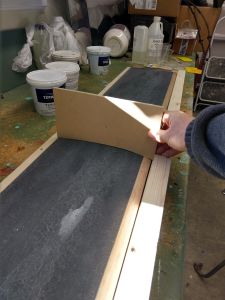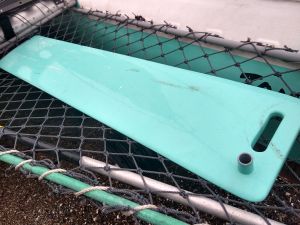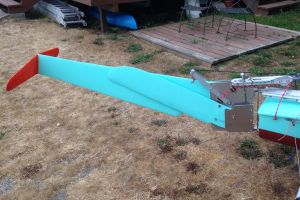Strips of white oak and purple heart used in making the t-foil core.
Jim's home | Trimaran home | This boat's home
This boat has 2 rudders, the big t-foil rudder that provides approx. 30% of the hydrofoiling lift, and the shorter, traditional one used when getting under way and in shallow water. A bit like a Swiss Army knife. With various ropes and cleats, plus a pin you can deploy either rudder. In my shallow bay you start out deploying the short one. Then in deeper water you point into the wind and come to a halt, retract the short rudder, deploy the t-foil rudder, deploy the main foils, then go have fun.
Strips of white oak and purple heart used in making the t-foil core.
Crude sketches exploring the design. It's complicated. Even in this drawing you can see that the t-foil rudder will need to pivot up more to stay out of the water when the boat is moored at its buoy.
Partical board prototype of the t-foil rudder.
Prototype of the pivoting mechanisms for both rudders.
Plywood core faired with purple heart leading edge.
This picture shows lengthening the Solcat daggerboard and rudder using divinycell and carbon. Worked fine.
Constructed and with fairing compound. Needs sanding and final layers of glass, then paint and hardware.

I made a 5' long daggerboard made from a high density foam core with white oak used for the leading edge and bottom, then wrapped in unidirectional carbon and glass. I shaped it with a planer, rasps and sanding blocks, then faired it with fairing compound. Since the profile of the daggerboard was consistent from top to bottom, I made a template to spread the fairing compound consistently. Also made a jig on my bench to secure it while doing so. It worked very well.

The finished daggerboard. When sailing version 2 of this boat I found that you do want the daggerboard down a third or half way to initiate foiling.

Finished rudders installed on boat.